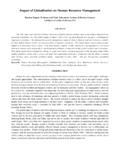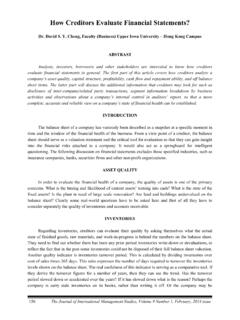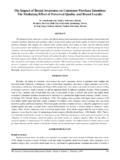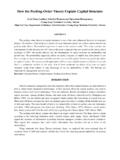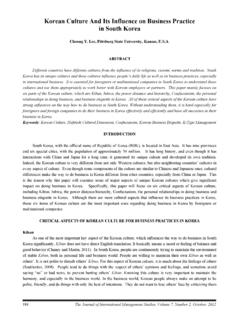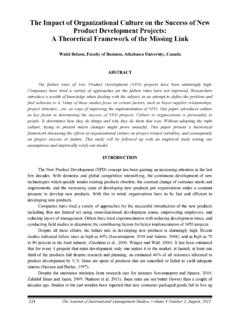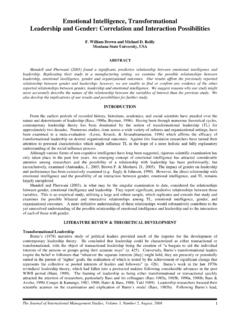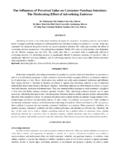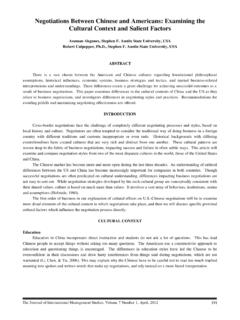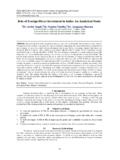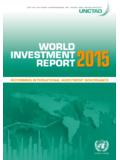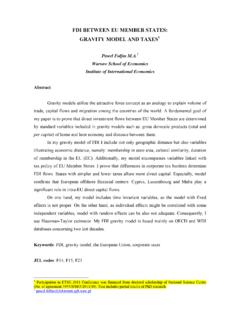Transcription of The Positive and Negative Impact of Remittances …
1 The Journal of International Management Studies, Volume 7 Number 1, April, 2012 7 The Positive and Negative Impact of Remittances on Economic Growth in MENA Countries Hadeel S. Yaseen, Assistant Professor, Accounting and Finance department, Al Ain University of Science and Technology, UAE ABSTRACT In the worldwide economy, Remittances represent one of the major international flows of financial resources. Sometimes the flows of Remittances can exceed the flows of foreign direct investment (FDI). For centuries, economists have tried to recognize why some countries reflect strong economic growth, while others stand still at low levels of output. This effort led to a numerous of possible determinants of economic growth including financial development.
2 This study aims to observe the impacts of Remittances on economic growth, using panel data set of MENA countries, Algeria, Egypt, Jordan, Libya, Morocco, Oman, Syria, Lebanon and Tunisia, during the period 2000-1010. These countries have experienced a major increase in remittance inflows, and at this time accounts for the bulk of total remittance receipts, compared with other regions. Most countries, Remittances represent the largest source of foreign exchange earnings and represent more than 10 per cent of GDP. Hence, it is worth noting that while some countries are net providers of Remittances (the Gulf Cooperation Council Countries), others such as Jordan, Egypt, Morocco, Tunisia, Lebanon, and Syria are known to receive large amounts of workers Remittances .
3 In other words, the econometric analysis will be based on those remittance receiving Arab countries. The paper is then to review the theoretical as well empirical literature devoted to Remittances , in order, first, to select the arguments that can be applied to this region and, second, to identify empirically if there are significant relationships between Remittances and growth in these countries JEL Classification: C3, 01, F3, F22 Keywords: Remittances , Economic Growth, Panel Data, MENA Countries. INTRODUCTION The growth performance in the Middle East and North Africa (MENA) region has been fragile and unsatisfactory. For example, over the last two decades, real per capita GDP in the MENA region stagnated, compared to average annual growth of percent in east Asia and percent in all other developing countries over the same period (Hakura, 2004).
4 Naturally, this lack of economic growth should be a challenging issue to policy-makers because it exacerbates the problems posed by the already existing high unemployment rates and the relatively strong growth in the labor force of the region1. The argument that the development of well-functioning banks (financial development) is expected to positively affect economic growth is well supported by many cross-country, industry-level and firm-level research papers2. For example, Chuah and Thai (2004) examined this issue for a group of Arab Gulf Countries. Based on bank credit to the private sector (as a measure of financial development) and the ECM and VAR models, the results indicate that financial development has a role to play in the economic development of those countries3.
5 1 The empirical literature attributes the poor performance in the MENA region to myriad of factors (see, for example, Dasgupta et al. (2002); Sala-i-Martin and Artadi (2002); Chan and Gemayel (2004). 2 Levine (2003) and Demetriades and Andrianova (2004) provide excellent overviews of this literature. 3 Trabelsi and Boulila (2003) and Ben Naceur and Ghazouani (2003) examined the MENA region in terms of the causality issue in the finance and growth nexus The Journal of International Management Studies, Volume 7, Number 1, April, 2012 8 It is broadly acknowledged that international migration has become a global phenomenon. Indeed, about 3 percent of the world's population are counted as migrants (Harrison, 2004).)
6 Besides, while migrant Remittances are recorded at US$93 billion in 2003 (Ratha, 2004), they are estimated at US$200 to US$300 billion (Migrant Remittances , 2004). The sheer volume of Remittances has captured the attention of academics, policy-makers, donor, international organizations, and others. Much of this research is devoted to three main questions. First, how large are the unofficial (unrecorded) Remittances ?4 Second, what are the determinants of Remittances ?5 Third, what is the developmental Impact of Remittances ?6 The importance of this paper stems from two observations. First, the limited empirical evidence shows that controlling for financial development enhances the Positive Impact of Remittances on growth (Mundaca, 2005).
7 Second, as far as we are aware, the Impact of Remittances on financial development has been examined by one recent paper only (Aggarwal et al., 2005). Based on their analysis, which included a total of 99 countries, they state that Remittances have a significant and Positive Impact on bank deposits to GDP, suggesting that these flows do find their way into the formal financial system and get deposited in banks (Aggarwal et al. 2005: 19). However, this analysis relied on a rather heterogeneous set of countries whose financial systems are at very different stages of development. THE Positive ASPECTS AND THE Negative ASPECTS FROM THE CONSEQUENCES OF THESE TRANSFERS The Positive effects of Remittances in terms of economic development The spread channels by which the funds of Remittances of the emigrated workers can have Positive effects on the growth of their home country.
8 The transmitted funds can fund the dynamic investment, moreover , when these funds are deposited in financial institutions whether local or intentional in terms of savings, this will imply a significant increasing and raising in the financial resources of these financial institutions, hence it will encouraging these institutions to expand its performance by granting more credit to the companies in their markets for short or long term loans, and granted by non banking financial institutions to companies or households; on the other hand, when the families of the emigrated workers encounter difficulties of credit rationing, the Remittances enable them to get out of these difficulties and are able to finance their needs for consumption or their capital expenditures.
9 Of course, in order this effect takes place, it is necessary that the families which receive these funds, be driven to do that. At macroeconomic level, increasing the total capacity of financing of the investments that brings this saving coming from abroad, plays a pro-cyclic role if the migrant workers abroad trust the local economic situation and if the financial system of the country encourages them to invest. But one could also observe that Remittances , for certain countries and in certain circumstances, play a counter-cyclic role: it is the case if, when the country of origin of the migrant workers is a poor country which knows a period of economic crisis, these workers send more Remittances to help their families to overcome these difficulties more easily.
10 Studies like Bobeva s (2005) or Chami et alii s (2003) ones analyze different aspects of this question to turn Remittances into investment or to verify if remittance flows are an actual source of physical capital improvement. And the answer to this question is not always Positive (cf. Chami et alii, 2003). Despite the fact that Remittances can have to somehow pro-cyclic effect, and sometimes counter-cyclic. Sayan (2006) shows, the way in which the migrant workers answer the cyclic movements of the GDP in their home country. In his study , he develops at the same time theoretical and empirical analysis on the evolution of flows of Remittances in twelve developing countries over the period 1976-2003, and on their business cycle characteristics, the Remittances receipts follow a compound secular dynamics, either pro-cyclic, or counter-cyclic, which must encourage with prudence in the analysis of their implications according to the considered country s economic situation.
